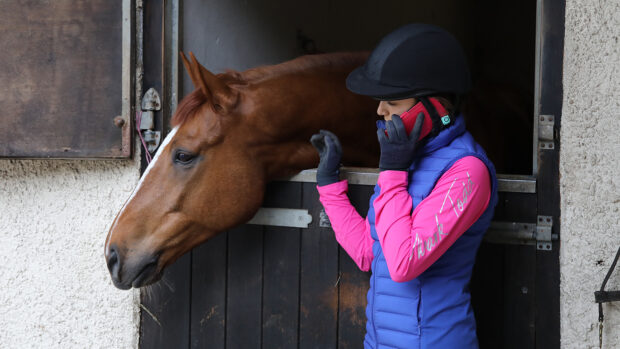Understanding equine insurance policies can be mind-boggling. H&H asks the experts to answer the questions that you thought were too obvious to ask.
1. When taking out insurance, do I need to have my horse vetted and should I tell the company about previous illness and injuries?
Guy Prest from KBIS says: “At the inception or renewal of the policy, you will be asked various questions about the health of the horse. These must be answered in full so that the insurers are in a position to accurately underwrite your policy. If pertinent information is withheld, it may result in claims being denied, or at worst, the policy being cancelled.
“Requirements for vet certificates will vary depending on the type of cover, value and from company to company, but in general, a vet certificate is needed if the value is over £6,000 with vets fee cover or whenever permanent loss of use is included.”
“It is important to advise your insurance company of everything you know about your horses’ medical history; when you first take out cover, and throughout the duration of your policy,” says Kate Hopkins, Petplan equine marketing consultant. “The more your insurer knows about your horse’s history, the more accurate exclusions will be, leaving as much covered as possible.”
People often think that if they don’t make a claim or tell their insurer that their horse has been injured or unwell then an exclusion will not be placed.
“This is not true; insurance is for the unexpected, so if a horse has a previous condition, that condition will not be covered,” adds Kate. “It’s the length of time the condition will not be covered for and exactly what is excluded that is determined by the information you and your vet share with the insurer.
“Petplan Equine review exclusions on a regular basis and often they can be removed following a period of the horse being well again.”
Even when an exclusion cannot be removed, it can often be narrowed down to something very specific.
“The review criteria can differ depending on the condition and its severity, so it’s important to speak with your insurer before asking the vet to provide any information,” says Kate.
2. Why has horse and pony insurance become so much more expensive?
“Insurance premiums reflect the risk. An insurer cannot pay for claims if they have not received enough premium to cover the payments,” explains Nicolina MacKenzie of South Essex Insurance Brokers (SEIB). “With advances in treatment some conditions that once would have been considered terminal can now be treated, but at a cost. In addition, the options for diagnostics have increased dramatically, for example, MRI scanning, which is a very important tool for veterinary surgeons. But the machinery is expensive and each scan costly for the horse owner or insurer.
“As veterinary costs rise year on year the insurance premiums increase so that the insurers can continue to afford to provide the cover. Just because a horse is insured doesn’t mean the treatment is free; the insurer pays for the costs, protecting the owner.”
3. How can you reduce your premiums while still remaining protected?
“As horse insurance premiums rise to reflect the claims experience of the insurer, there are still ways to reduce the premium,” says Nicolina.
These include:
- Do not over-insure for the activities the horse participates in. For example, don’t insure for hunting or eventing if you just hack around the block. The activities have a direct effect on the premium paid.
- The other option is to consider increasing the excess paid following a claim. By increasing the excess from around £100 to £250 or maybe £500 for each and every claim made, the premium reduces considerably. Many horse owners can afford to pay £500 for veterinary treatment, but need to be protected against a large bill, which could end up being thousands of pounds.
- Another option is to ask for co-insurance, which means that you pay a percentage of the cost of the treatment, as this can also reduce the cost of the premium.
- Do not pay for cover that you already have elsewhere. For example, tack and saddlery may be covered under the all-risks section of your household cover, and you may have liability insurance included within the membership of an equestrian organisation.
- Don’t under-insure as this would be a false economy. If there is a complete loss [that is, the death of the horse], the insurer will not pay for a full replacement if the appropriate premium has not been paid. But don’t over-insure either, as the insurer will only pay out on market value.
4. Do I have to have third-party cover to ride on the road?
“Unlike with motor vehicles, there is no legal requirement to hold third-party liability cover to ride on the roads,” says a spokesperson from Shearwater Insurance. “However, it is always advisable to have this cover as, in our experience, the most common claims made on this type of insurance are for motor accidents. Although third party can normally be added to a horse policy, it is not always the case as not all insurers are licensed to write this type of cover.
“There are other ways of ensuring you are covered as many organisations, such as the British Horse Society, British Showjumping, British Dressage and British Eventing, offer this cover as a benefit of membership.”
5. Am I covered if other people ride my horse or I put my horse on loan?
“Normally cover is not affected by who is riding your horse for any section of the policy, as long as the person is riding with the policy holder’s permission,” explains the Shearwater Insurance spokesperson. “However, you should be aware that a person who has permission to ride your horse cannot claim against you on the public liability section of the policy if anything happens to them.
“Personal accident sections of a horse policy will normally cover anyone who is riding or handling the horse (unless it is a commercial arrangement). There are special arrangements for horses on loan depending on whether the policy is in the name of the owner or the loaner regarding who gets paid out for each section of the policy.”
6. Can I just insure for vet fees?
Kathleen says: “Vet fee-only insurance is not possible with any of the companies we use, nor have we heard of any offering it recently. It is usually offered as part of a package.”
KBIS’s Guy Prest agrees: “Most companies want an element of mortality cover if insuring for full veterinary fees, however it is sometimes possible to under insure your horse’s value meaning that you get a cheaper policy with the vets fee cover you require. You can also buy more limited vets fee cover as a standalone policy, such as KBIS catastrophe cover (which offers cover for accidental external injuries, joint and tendon sheath flushing due to sepsis, colic surgery (surgery costs only) and surgery for pastern and pedal bone fractures) or cover for accidental external injuries only which tends to be popular with owners of retired horses.”
7. How easy is it to claim?
Kate advises: “With Petplan Equine, claiming is a really simple process, you just need to fill out a claim form and send it to your vet to complete their section and return to Petplan Equine with your horse’s veterinary history. Some insurers, like Petplan Equine, have the option to pay your vet directly so that the client doesn’t have to pay for treatment first and they can focus on looking after their horse.”
Having the correct documentation will cut time, as Guy explains: “Make sure all the documentation is completed accurately by the policy holder and vet, and all invoices are included. If these are supplied at KBIS, we try to turn claims around in 48hours. The ones that take longer are either due to incomplete documentation (either from the current claim or inception of the policy) or issues over non-disclosure.”
You might also be interested in:

9 insurance blunders (and how to avoid them)

What is loss of use insurance for horses and how does it work?

Subscribe to Horse & Hound magazine today – and enjoy unlimited website access all year round
Horse & Hound magazine, out every Thursday, is packed with all the latest news and reports, as well as interviews, specials, nostalgia, vet and training advice. Find how you can enjoy the magazine delivered to your door every week, plus options to upgrade your subscription to access our online service that brings you breaking news and reports as well as other benefits.




